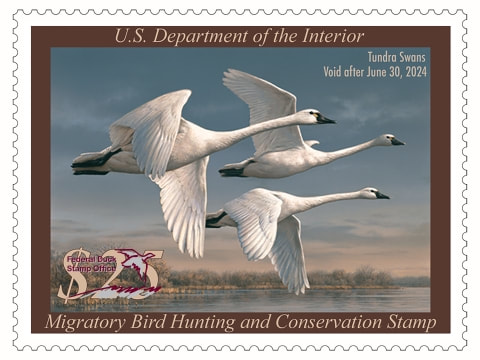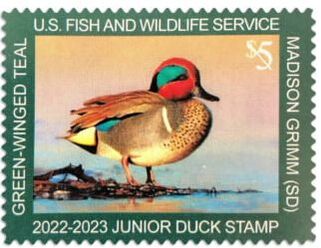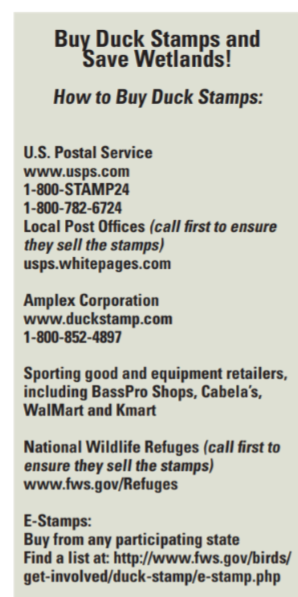Federal Duck Stamp Program
|
Put your stamp on conservation.
One of the easiest ways that anyone can support bird habitat conservation is by buying Federal Duck Stamps - among the most successful conservation tools ever created to protect habitat for birds and other wildlife. Federal Duck Stamps are conservation revenue stamps; 98 percent of the purchase price goes directly to help acquire and protect wetland habitat and purchase conservation easements for the National Wildlife Refuge System. Wetlands acquired with Duck Stamp dollars help purify water, aid in flood control, reduce soil erosion and sedimentation, and enhance outdoor recreation opportunities. One stamp, many uses. While waterfowl hunters 16 years of age or older are required to purchase them, anyone can contribute to conservation by buying Duck Stamps. In addition to serving as hunting license and conservation tool, a current Federal Duck Stamp is also a free pass into any national wildlife refuge that charges an entry fee. Because nearly all of the proceeds are used to conserve habitat for birds and other wildlife, birders, nature photographers and other outdoor enthusiasts buy Duck Stamps to help ensure that they can always see wildlife at their favorite outdoors spots. Federal Duck Stamps are sold at many sporting goods stores and other retail locations - both large and small - that sell sporting and recreation equipment. You can also buy them at many national wildlife refuges, and online through Amplex. As an added convenience, especially for hunters, the E-Stamp program allows you to buy a Duck Stamp online and instantly obtain a printable receipt good for 45 days, within which time a physical Duck Stamp is mailed to you. A unique and collectible work of art. Also known as the Migratory Bird Hunting and Conservation Stamp, the Duck Stamp was conceived in 1934, when Congress passed and President Franklin D. Roosevelt signed the Migratory Bird Hunting Stamp Act (later amended to the Migratory Bird Hunting and Conservation Act). The first Duck Stamp was designed by J.N. "Ding" Darling, then director of the Bureau of Biological Survey (forerunner to today's U.S. Fish & Wildlife Service). In addition to being the only conservation revenue stamp, the Federal Duck Stamp is also unique in the way the stamp is created. Each year, the U.S. Fish & Wildlife Service holds an art contest, the only juried art competition sponsored by the federal government. Any artist 18 years or older may enter, and the winning artist sees his or her work featured as the design on the following year's Federal Duck Stamp. The Federal Duck Stamp Art Contest is open to the public; anyone can witness a bit of history in the making as judges select the winning art from among hundreds of entries. If you can't make it to the contest, you can still see original Duck Stamp entries; the top entries each year tour the nation, exhibited at museums, refuges, festivals and other venues. Federal Duck Stamps are miniature works of art, and they are prized by stamp collectors around the world. The stamp image is featured on products such as t-shirts, calendars, mugs and blankets, through the Duck Stamp Licensing Program. Many states issue their own duck stamps. In some states, the stamps are purely a collector's item, but in others, the stamps have a similar role in hunting and conservation as Federal Duck Stamps. Some states hold contests to choose the art for their stamps. |
Federal and Junior Duck Stamps are for sale at the Rookery Nature Store! The Rookery is open Wednesday - Sunday (10am-4pm), closed some federal holidays. Junior Duck Stamp: Conservation through the arts.
The Junior Duck Stamp Program is the U.S. Fish & Wildlife Service's premier conservation education initiative. The program teaches students across the nation conservation through the arts. Revenue generated by the sales of Junior Duck Stamps funds environmental education programs in all 50 states, the District of Columbia and several territories. |










